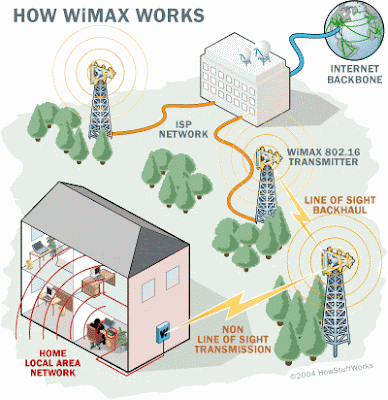WiMAX transmitting tower
A WiMAX system consists of two parts:
- A WiMAX tower, similar in concept to a cell-phone tower - A single WiMAX tower can provide coverage to a very large area -- as big as 3,000 square miles (~8,000 square km).
- A WiMAX receiver - The receiver and antenna could be a small box or PCMCIA card, or they could be built into a laptop the way WiFi access is today.
A WiMAX tower station can connect directly to the Internet using a high-bandwidth, wired connection (for example, a T3 line). It can also connect to another WiMAX tower using a line-of-sight, microwave link. This connection to a second tower (often referred to as a backhaul), along with the ability of a single tower to cover up to 3,000 square miles, is what allows WiMAX to provide coverage to remote rural areas.
What this points out is that WiMAX actually can provide two forms of wireless service:
- There is the non-line-of-sight, WiFi sort of service, where a small antenna on your computer connects to the tower. In this mode, WiMAX uses a lower frequency range -- 2 GHz to 11 GHz (similar to WiFi). Lower-wavelength transmissions are not as easily disrupted by physical obstructions -- they are better able to diffract, or bend, around obstacles.
- There is line-of-sight service, where a fixed dish antenna points straight at the WiMAX tower from a rooftop or pole. The line-of-sight connection is stronger and more stable, so it's able to send a lot of data with fewer errors. Line-of-sight transmissions use higher frequencies, with ranges reaching a possible 66 GHz. At higher frequencies, there is less interference and lots more bandwidth.
WiFi-style access will be limited to a 4-to-6 mile radius (perhaps 25 square miles or 65 square km of coverage, which is similar in range to a cell-phone zone). Through the stronger line-of-sight antennas, the WiMAX transmitting station would send data to WiMAX-enabled computers or routers set up within the transmitter's 30-mile radius (2,800 square miles or 9,300 square km of coverage). This is what allows WiMAX to achieve its maximum range.
Special Thanks goes to Prabath Ariyarathna..



1 comment:
Hey cool!
Why isn't this already a reality?
I hate the slow speeds put out by the cell phone companies!
I also would like to play my X-box out on the ranch!
Post a Comment